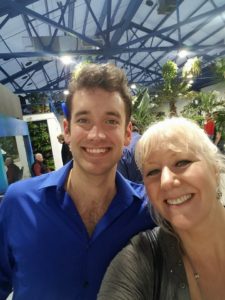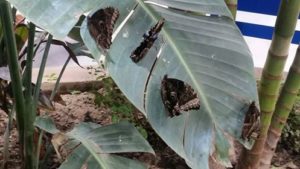
 By Austin Macfadden
By Austin Macfadden
This originally appeared March 1 in the Northeast Times. It is reprinted here with some editing as a courtesy of Broad Street Media, for which we are grateful.
The Insectarium, 8046 Frankford Ave. in Holmesburg, recently opened its butterfly pavilion to both professional and amateur insect enthusiasts.
The addition includes two classrooms, along with hand-painted bug murals of intricate design. The pavilion itself will be the home to some 10,000 types of butterflies.
“Of course, you can buy any insect over the internet. Type doesn’t matter,” Steve Kanya, president of the Insectarium since 1992, told the Times. “But that defeats seeing an ensemble of them, in one re-furbished location.”
The Insectarium is a member of the Greater Northeast Philadelphia Chamber of Commerce.
Nearby, an apparent relative of a tropical species of Dero Clearwing, Dircenna dero, flutters on Kanya’s elbow. A real breathtaking clear-winged specimen with dusted cyanine-tipped borders on the underside.
“We’ve made a lot of expansions recently. Our windowed chrysalis chamber is something we’re espe-cially proud of,” Kanya said.
With insects, specifically butterflies, as in countless other biological subjects, there are unquantifiable depths of aesthetic dimensions. That is what lures admirers, hobbyists and amateurs, from all walks of life.
The hope is that through conservation, nature’s process in its widest scope can be viewed and studied up close. Insects, after all, outnumber people across the planet’s surface.
The Insectarium has passionate people deliver heartfelt spiels, informative and entertaining.
“There are ten to fourteen days in the life cycle from caterpillar to butterfly,” said Dr. John Cam-bridge, CEO of the Insectarium and Butterfly Pavilion. “It would be misleading and anachronistic to suggest that because metamorphosis is so complex, it isn’t understood today.”
What catches the most attention are the Morpho blues. So named because when their owl-mimic pat-tern unfolds, it reveals a deep kind of reflective transparent blue.
Everything from millipedes to a hornets nest the size of filing cabinet are on display at the Insectarium.
Historically, both butterflies and moths have symbolized delicacy and power; their metamorphosis from crawling caterpillar to a flying adult has a perennial symbol of hope and rebirth, throughout time.
“They only have a ten-to-fourteen-day life span.” Cambridge said. “So, it’s important we supply a constant cycle.”
Hummingbird feeders act as a food supply and are dotted around the Pavilion, in addition to old citrus-heavy fruits like oranges and mushy bananas in order to feed the butterflies.
“Science is art. We hope that we can instill a sense of learning beyond just the classroom,” Cambridge said. “A good museum’s collection is never finished.”
